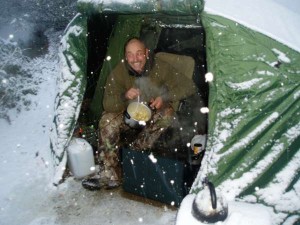
A very brave angler at Laroussi
This is the ultimate winter carp fishing bible, written by Tim Richardson, you’ll find everything you should consider when tackling cold weather carping below…
1. Location, location, location!
First find your fish; they may be indicated by other anglers catching fish, or come from where you caught previously. Past year’s records of hotspots and over – wintering areas can be very useful. But these can vary according to a season’s dominant prevailing winds directions and temperatures. Also fishing pressure, food availability, changes in the lake bed caused by moving / feeding carp, other fish present, e.g.; big over – wintering catfish etc can alter ‘holding areas!
Snags in the water like fallen trees, rocks etc, silt beds, gravel bars, old water lily beds, dying weed beds, water inflows, overhanging trees / bushes can all hold fish and all are worth a try. Also investigate cut – away banks, undercut margins, shallow margins in shade or sun where rolling / bubbling fish may be observed, in Winter on the end of a warmer wind or the back of a Northerly wind, reed beds, underwater humps, troughs, ‘food traps’ along the prevailing winds lanes, dips, smooth hard areas may well indicate a feeding area as will old silted up areas / bloodworm beds that produced fish previously in warmer times of the year.
Try places where there are sudden changes of depth as many harbour attractive natural food.
Especially gravel slopes, mud humps and ledges around islands, and at the edge of weed beds. Casting around to find underwater debris and old dying weed can help locate fish too as these areas harbour natural food. Finding the Study at quiet or under fished areas, and for the biggest fish – most often they’re caught in the areas where most bait goes into a lake (I know Dave Lane would agree concerning his UK fifties!!! etc..
Often in winter carp can be located in maybe 1, 2 or just 3 areas of a lake and will be shoaled up tightly together.
Casting all around the lake with a small lead and braided line methodically until you feel ‘bumps’ as you wind in (that are not there next cast) could be fish! Moving your hook baits every hour may be productive as you may find this roving approach lands right next to a fish or disturbs them into fresh activity / or ‘hearing’ your bait land and investigate out of curiosity.
2. Baits
Some say use smaller baits on the hook in winter, and I agree here.
I’ve had more takes on these and I use small baits in P.V.A bags or on stringers, especially using pastes and par – boiled baits mixed with quick dissolving bait / fishmeal pellets.
Bites in Winter can be very deceiving indeed and your indicators should ideally be set to maximum vibration / sensitivity as often just one or two ‘bleeps’ could be a hooked fish spinning or shaking it’s head trying to spit the hook while just ‘sitting’ in the water static without running. ‘Rod knocks’ can really produce carp that were perhaps only lightly hooked; Try quickly ‘twitching’ your rig with a swift pull on your line by hand to hook the fish!
I have found that the old traditional ground bait composed of broken up stale loaves with loads of extra highly attractive additives and extracts, like those containing alkaloid substances you would use in your boilie base mixes work very well. This form of ground bait is not used so often these days in the UK. Added ‘live food like maggots / worms bring much needed activity to the mix, and often will attract other species to feed first which stimulates the carp to follow just in time to polish off your hook bait!
On that note using a plastic ‘feeder cage lead’ wrapped in fast dissolving / breaking down ground bait as in the popular ‘method’ is a great way to ‘build – up’ and feed your swim with fast acting attractors importantly, without feeding up the fish! This so often can produce smaller fish too, e.g., using ‘artificial maggots or sweet corn on the hook, but I was at “Rainbow lake” in France when Martin Locke boss of “Solar” caught his very first 60 pound carp on ‘the method’.
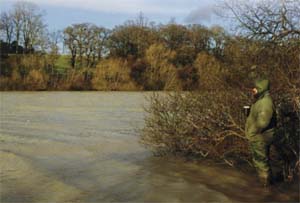
.
While fishing ideally use quantities of fast dissolving baits that can really turn the fish onto feeding without filling them up or suppressing their appetite!
A period of pre-baiting quantities either while fishing, or introducing bait into areas where warmer winds drive into or afternoon sun can heat up, not fished at the time, or while not fishing. Or any area that potentially could hold or be a feeding area or a ‘safety area’ where fish may move to de – leach themselves or bask in top water levels as sunshine hits the water, or in / adjacent to snags etc; I remember one winter finding fish literally ‘stacked-up’ tightly together in a depression within an extensive weed bed of dead ‘Canadian pond weed.’ at Shotgate reservoir, Essex 1984.
These fish were very easy to catch for a half – hour period each day and this time was like ‘clockwork for a period of about 3 weeks in December. Each day the feeding time changed by about 10 minutes so it could be charted and ‘kick-off’ could be predicted extremely precisely. It was exceptionally fruitful and exciting fishing and I kept the action going by using lots of basic, simple small roughly chopped ‘par-boiled’ and paste balls; yeast based milk protein baits with added coffee and chocolate drink powders. (For extra attractive ‘alkaloid’ content – they’re addictive!)
I also added “Ultra Spice” and “Chocolate Malt” flavours at 4 millilitres of each per pound of dry mix. I also a liquid protein source additive (Rod Hutchinson’s “Regular Sense Appeal” at about 60 millilitres per pound of bait. And I used this in dips too) – awesome stuff. Carp stimulating alkaloids are excellent when used in winter baits especially! For example betaine / betaine hydrochloride, and others e.g., as found in coffee, corn steep liquor molasses, black pepper, cayenne / chilli peppers, etc, and similar compounds such as in hempseed.
Fish pulling methods to trigger fish feeding:
Try using dissolving baits, Poly Vinyl Alcohol (water soluble) stringers with baits on or P.V.A bags. These are excellent for delivery of larger quantities of bait, maggots and even oil based liquid attractors into your swim, or even fine ground bait or pellets etc.
Add some natural butyric acid to boost your winter baits:
For great added attraction, simply add finely grated parmesan or blue cheese. These baits have been proven fish catchers for years; it’s their butyric acid content, quite apart from their fat / protein / salt and taste enhancing properties!
Our winter carp thinks; “I’d like the fastest and easiest bait to digest as possible please!” Why we don’t use beef for carp baits much! (It’s not just cost) And use quality fish / milk proteins instead! The time taken to digest food and the ‘negative energy expenditure’ cost of digestion of beef in contrast to fish, turkey or chicken partly demonstrates how fish nutritional bait requirements need careful consideration, especially in cold water / slow metabolic and digestive rate conditions. As a personal example – you remember that ‘constipated / ‘full’ feeling after a large beef meal don’t you? (You don’t fancy much to eat afterwards!)
Ideally use the most easily digested baits / fastest dissolving baits / free bait:
For the most winter takes. NB: Natural baits like maggots are ideal, being already mostly liquids!
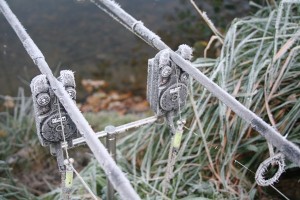
.
Natural baits and ‘traditional’ baits:
E.g., utilising the effectiveness of frozen bloodworm in a feeder and using artificial blood worm on the hook, and ground bait to really get takes when it’s really cold and carp seem to have ‘turned right off and ‘hibernated’! e.g., bagging up flavoured maggots etc to build up a swim – pre-empting known feeding times in winter to prepare the swim in advance. E.g, with feeding triggers soaks / dips, e.g. luncheon meat and spice oils / aniseed oil, e.g., flavoured worms, maggots with Tutti Fruity or Scopex flavours or Robin Red liquid additive etc.
Use maximum attraction, high leak off soluble pastes:
For feeding the swim and moulding on the hook / or hook baits e.g., milk proteins, bird foods, high protein fishmeal e.g., shrimp, krill meal / shellfish meals / corn steep meal etc.
Try adding extra high levels of attractors for extra pulling power:
E.g.; green lip mussel extract (betaine source), squid extract (taurine amino acid source), kelp powder (highly pungent plus packed with attractive minerals etc), corn steep liquor (Betaine source), various milk powders and extractions (attractive water clouding effects, taste /smell; milk sugars, fats, free and whole proteins, etc.)
Or perhaps address extra flavours / attractors to your swim using dissolving pellets soaked in attractors with the advantage of not feeding the fish as you would with whole boilies.
Flavours:
Take into account that solubility of flavours is lowered in colder water. So try over flavouring your baits. For example by including raised levels of liquidised liver, or pre – digested liver powder, or yeast extracts, for extra pungent pulling power and freely soluble proteins for better attraction.
Adding taste enhancers promote more intensive feeding and alter the bait taste profile. Yeast extract or grated parmesan cheese contain a very carp attractive amino acid. Spices, sugar, salt all add different bait benefits. Really take advantage of amino acids ‘bait glugs’, dips etc. Add lobster extract liquid to add a different alkaloid (betaine) source, by pre-freezing your baits in it!
The advantages of using sweeteners: Scientifically it has been proven that when provided with two identical fully balanced foods but one is sweetened, carp will prefer the sweetened one! Carp love them! Sweeteners can vary from artificial ones like aspartame to natural fruit sugars like fructose, and from liquorice extract to ‘talin’ (an exceptionally sweet bark extract), to molasses (a great nutritional betaine source.)
Palatability is a critical factor in carp baits:
Why do you think tinned and pre-packed food producers put so much sugar, salt and taste enhancers in. They even add sugar and salt to the brand new ‘genetically modified ‘super sweet’ sweet corn in the cans. Sugar is addictive incidentally! And salt is vital to carp nutrition and balanced physiological health.
Using ‘single hook baits’:
Carp seriously ‘know’ their aquatic environment and if anything happens or changes they are very quickly aware of it. Putting single highly flavoured / coloured baits out to perhaps known feeding / holding spots is a productive method at times, especially if fish are wise to beds of bait and may feed on hook baits more confidently sometimes when they are ‘solitary’ ones with no free offerings nearby.
Fishing upper water levels:
Very often anglers blank and don’t catch fish, even though they may see the odd carp roll in their swim while fishing. This could be they are fishing hard on the bottom, where perhaps the fish find it uncomfortable to feed; perhaps water temperatures / water oxygen content / water PH is not quite right for carp to feed there at that time.
However, often carp will sit suspended in the mid to upper layers of the water where it’s more comfortable for them. Float fishing can work here or try ‘Zig – rigs’; these are long hook links with buoyant baits on the hook used to intercept those mid water carp – it can really work!
Using P.V.A bags / stringers paste / boilies mixed:
How about trying milk powder and powdered flavours with sugars in P.V.A bags along with your favourite ‘bag mix’. Try coffee powders, cocoa Powder, or perhaps raw cane molasses for a different effect. There are so many ‘alternative’ attractors available which can be more effective as the fish may feed more confidently on ‘new’ ones they have not been caught on yet! Always buying those ‘fishing shop’ baits can lead to a reduction in your catches!
Advantages of using ingredients and attractors that promote a feeling of well-being and health in carp:
Put ingredients in your baits that help the carp and they’ll reward you by liking your bait more! Such effects could include: thinning their blood, helping them break down glycogen in the liver faster, or speeding up digestion, improving effective assimilation of food, cleaning the carp’s blood, stimulating the nervous system, stimulating the immune system, triggering digestive processes in / around the carp’s digestive tract, giving carp an immediate ‘high’ by using Opiate Alkaloids e.g., in wheat and milk.
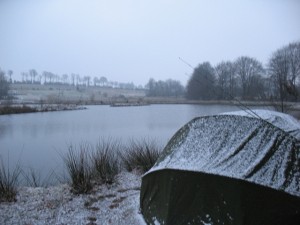
.
Using Paste hook baits and adding pre – digested proteins: In added layers around your par – boiled hook baits, or normal boiled hook baits for amazing carp attraction.
Neutral baits:
Baits made with the minimum ingredients that have ever been tested or eaten before by carp. Try to create a ‘carp friendly’ safe bait with minimum ‘danger reference points’ regarding over-used ingredients flavours and attractors – the aim is to be original and different to fool those angler trained carp!
Changing and manipulating carp’s usual sensory ‘danger reference’ points:
Regarding your baits, rigs, hooks, leads, lines, baiting patterns, attractors, bait ingredients used, and excluding carp the maximum number of danger signs from baits, rigs, hooks.
Herbs are great in carp baits:
They especially aid digestion and affect the beneficial physiological and stimulatory systems and processes in fish. Good examples are fenugreek, Dill, Basil, ginger, garlic, onion, etc.
Winter spices:
Use them raw in P.V.A bags; ‘Curry powders’ are nature’s digestive stimulators! Look at the ingredients in curry powder and discover the richness of these amazing extracts and powders.
These promote that familiar ‘just one more please syndrome’ (alkaloids do this – think nicotine!) This effect can over – ride the ‘I’m full up now’ brain signals to the digestive system; to produce you more carp takes!
Creating an exceptionally carp – attractive ‘salt hot spot’:
Really pull in the carp by using high levels of mineral rich sea salt in your free baits / ground baits for freely released, highly attractive mineral salts into the water around your baits. (Many minerals are essential in carp’ diet)
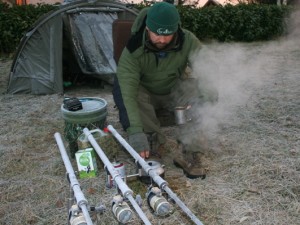
.
Maximise the ‘curiosity value factor’ of carp behaviour:
Use mud or soil, fine ground bait and frozen bloodworm, to cloud up the water to produce so called ‘slop’ ground baits. Try crushed cooked fermented mixed seeds for maximum clouding and attraction effect for prolonged intensive feeding.
Optimise highly coloured boilies by mixing colours / even types of boilie base mixes with different colours to make your feeding area a bit different!
Using ‘instant baits’ for opportunistic carp:
Most carp can live on natural food and low protein baits without affecting fish health and fishing results too much short term. But you may need to keep ahead of carp’s ‘danger recognition’ by association with getting caught on them on ‘pressured waters. Constantly change the flavour or attractors you use, in your low protein baits and stay ahead of the fish!)
Of course on a small fish water / ‘hungry water’ or water where fish feed throughout Winter – time then these cheaper plentiful baits will be part of the carp’s ‘staple diet’ and will be taken habitually anyway.
Over – flavoured or over loaded-attractor boilies:
E.g., (Using double the recommended flavour levels.) Cheap low protein baits such as the semolina and soya flour based ones, (some with added fishmeal or bird foods, are excellent winter baits. ‘Attractor baits’ that fit into this category mainly exploit one or two facets of carp attraction involving flavour smell or bait PH. Some baits may have added attraction e.g., betaine source like corn steep liquor as an added ‘food’ source signal,; so fooling the fish that their nutritional reward for eating this bait will be greater.
3. Tactics
Fishing by ‘Stealth’ with float fishing tactics in marginal areas, snags or tricky areas where static conventional ‘rods behind alarms’ and conventional line angles are a barrier to success:
Stalking improves chances by you actually finding fish, finding fish holding features, and actively feeding fish you may have missed! It takes advantage of a more quieter, subtle fishing approach which also avoids those nasty ‘dangerous’ tell – tale lines running through your swim at the usual angles to fishing spots.
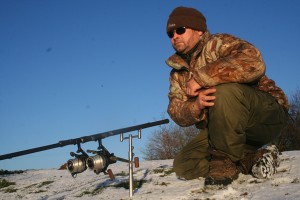
.
Your carp may not be feeding, but at least you’ve located fish! I once found a ‘common’ carp of around 20 pounds in weight, only a foot away from the grassy bank, one sunny afternoon. When I tested the fish’s awareness reactions, I was very surprised to find I was able to literally lift it right out of the water and onto the grassy bank! Whereupon I replaced it gently back and it slowly swam away! It was an extremely cold January and the water iced over most nights. Using double, treble, sliding hairs, sliding rigs, or long length lead back stops to ‘trip – up’ slow moving wary carp in Winter : Using different types of baits on different hairs, using multiple tiny baits on multiple hairs. These are two methods many anglers forget when times get tough, and fish are more ‘picky’ about the baits they sample confidently.
Should you use shorter or longer hooklengths and hairs in winter? Each and every design has their day, taking into account different types of feeding activity / physical conditions. For example when fishing in silt, bottom debris, old weed, over hard gravel, etc. Adjusting baits of different density, attractor types and rates of leak-off, weights of leads, hook sizes, hair lengths, vary the way the bait and rig move in water. Also vary different bait shapes sizes and bait buoyancies.
All these things can change a blank day into a very memorable ‘red letter day’ even when thick snow is on the ground and your only warmth comes from the whiskey in your coffee flask!!! Cheers! (Warning: This article is protected by copyright.)
By Tim Richardson
‘The thinking angler’s EXPERT BAIT MAKING GURU.’ Take a look here
Thinking of taking a French carp fishing trip in winter or early spring? We often have great offers on at some of our carp lakes in France, take a look here – Carp Fishing in France Offers

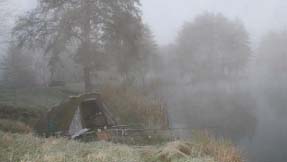
[…] and Share More » Powered by […]
Hi Im from South Africa and brand new to specimen (Carp angling). I’m interest in various rigging methods that work. Any advise will be appreciated (with diagrams)
strawberrys on a rig is a very good bait to use on the bleeper
and the tiger nuts eassyyy
bit of sweetcorn on a float with a bit of hemp catches good carp
Thank you very much for all these tips and lessons, very helpful! Great Blog!
Thanks Mart!
Absolutely fabulous piece! thank you for an excellent insight into the wonderful world of the line freezing to the rings so that when a take occurs (rarely in my case) the whole rod just leaps into the water! I am going to keep reading this and find the top ten tips for me. (No. 1 will be just to get out there in the winter!). Regards Les
Excellent, enjoy Les!